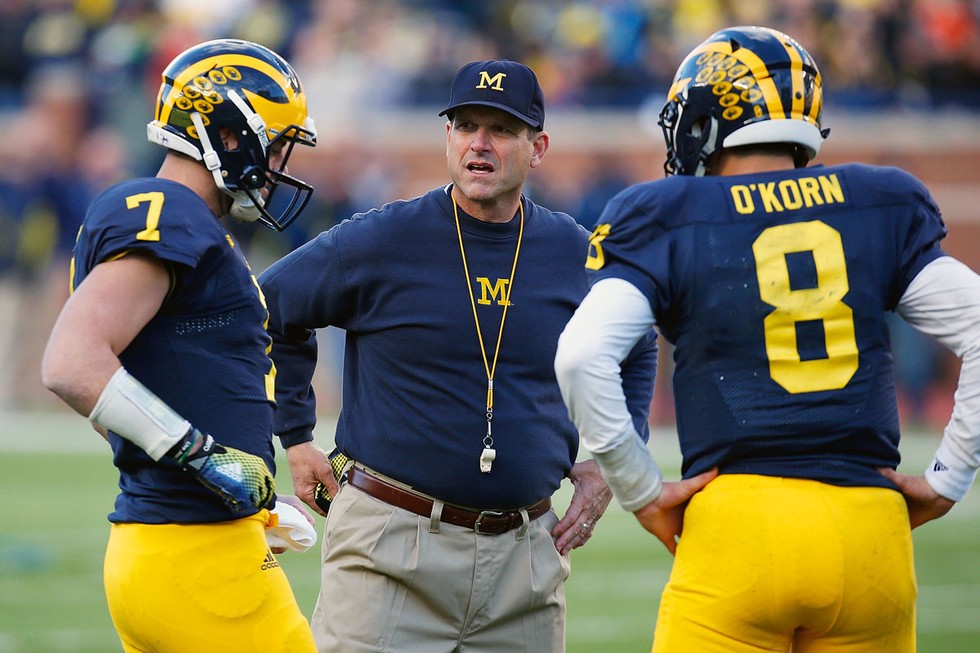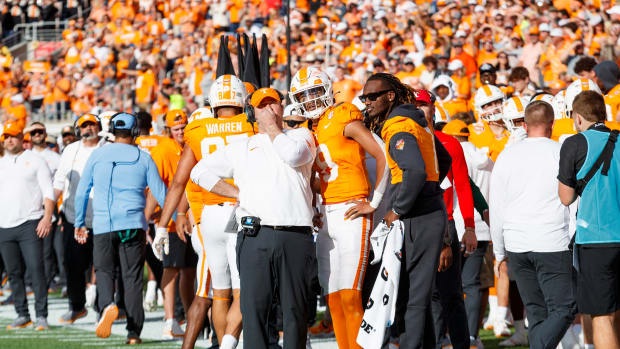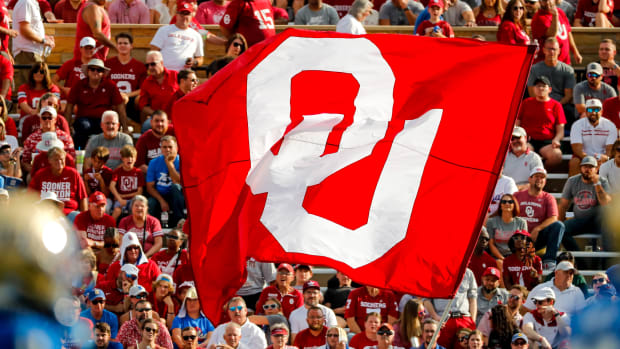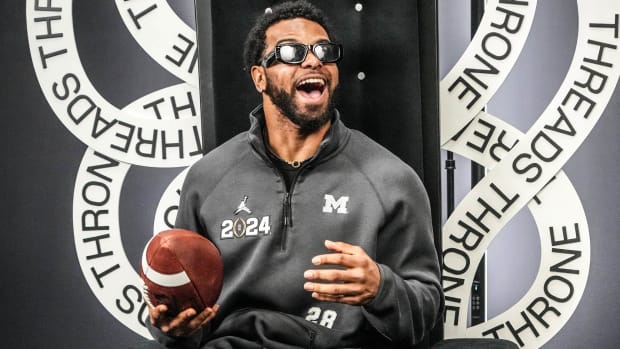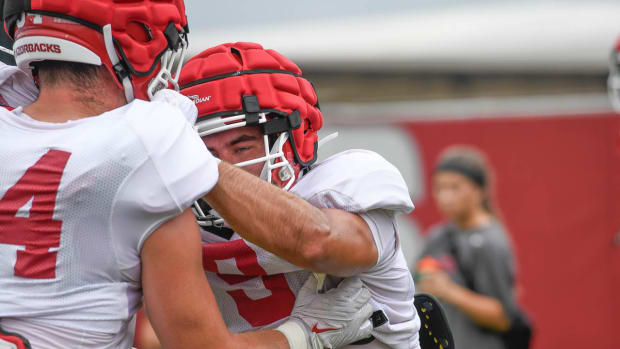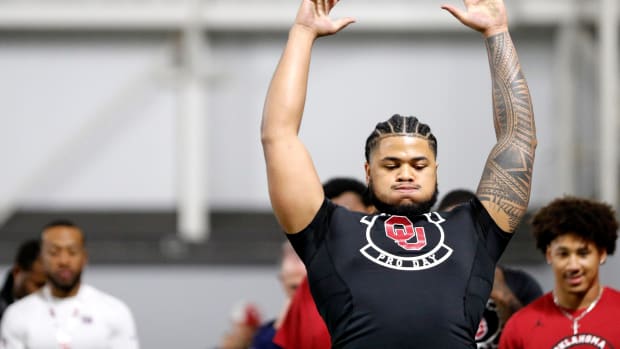Cause for optimism in Ann Arbor: Takeaways from the Michigan 2016 spring football game; Punt, Pass & Pork
[video: 13724924]
ANN ARBOR, Mich.—Spring games aren't supposed to end on a video review. The result isn't supposed to matter that much. But judging by the way the Maize team swarmed the field Friday to celebrate A) stuffing Blue team fullback Henry Poggi on a two-point conversion attempt and B) the officials' confirmation that Poggi was indeed stuffed, the result mattered a great deal to the Wolverines. The way the night's Victors discussed how they would hold this particular 14–13 victory over their teammates' heads suggests the Michigan players take every competition quite seriously.
Friday's winners got steak and the losers got spaghetti—second-year Wolverines coach Jim Harbaugh's twist on a tradition he borrowed from his old coach, Bo Schembechler—but the menu meant far less than the psychological reward. "Bragging rights for life," Maize tight end Jake Butt said, and he was only sort of joking. Butt and Maize linebacker Ben Gedeon live with Poggi, Blue offensive lineman Patrick Kugler and Blue quarterback/receiver (more on that later) Shane Morris. "Poggi's never going to hear the end of it," Butt said. "Fullback dive on the one? You can't be denied like that, Henry."
You know what else isn't supposed to happen in spring games? When a draft divides the roster in two, mixing first- and second-teamers, the offenses aren't supposed to be able to operate efficiently without five coaches on the field. Harbaugh stood behind each offense, but for the most part the blend of ones and twos operated as if they were playing in the fall. With the play clock running, the starters and their backups were disciplined enough to play together as if they had been practicing in those combinations for months. Even without their best receivers, they also managed to move the ball against a defense that should be one of the Big Ten's—and maybe one of the nation's—best.
That alone shows how far Michigan has come since Harbaugh arrived on campus. In the Wolverines' final spring practice under Brady Hoke in 2014, the program held a situational scrimmage instead of a traditional game. Even then, the first-team offense could barely squeeze off a play without one or multiple defenders crashing into the backfield. A spring-game failure on offense equals success for the defense, so the practice didn't offer definitive proof that the upcoming season would be a disaster. Instead, it presented two options: Either the offensive line couldn't block anyone or the defensive front was going to be a monster. Michigan's defensive line was good in '14; it wasn't a monster.
The level of competence on both sides of the ball Friday bordered on startling. The team has two legitimate options at quarterback in redshirt sophomore Wilton Speight and Houston transfer John O'Korn. It's possible 6' 3", 228-pound USC transfer Ty Isaac will provide another solid option at tailback either behind or in front of De'Veon Smith. Isaac spent time on Harbaugh's bad side last season, but he has dropped 14 pounds in the off-season. On Friday, he ran for 84 yards on 10 carries. The Wolverines are also awash in tight ends. We all saw what Butt could do last year, when he caught 51 passes for 654 yards, but the development of Ian Bunting, Tyrone Wheatley Jr. and Zach Gentry suggests Michigan is starting to morph into something similar to what Harbaugh had at Stanford. At 6' 6" and 291 pounds, Wheatley can overwhelm linebackers and safeties as a blocker in the run game. Then he makes catches like the one he made in practice last month at Ford Field, and the mind races about how Harbaugh and assistant Jedd Fisch might utilize a double tight-end combination of Butt and Wheatley.
All of this may sound a bit too optimistic. Sure, Michigan improved dramatically in Harbaugh's first season, going from 5–7 to 10–3, but it also was smoked at home by Ohio State in November. To get where they want to go, this year's Wolverines must leapfrog the Buckeyes and defending Big Ten champ Michigan State, and Michigan plays both those teams on the road this fall. Still, even though Wolverines coaches probably won't choose a starting quarterback until preseason camp, Harbaugh's squad has fewer unanswered questions than those other two.
The defensive line is deep, and barring terrible injury luck it should hold up. In last season's 42–13 loss to Ohio State, the line was so ravaged by injuries that it allowed the Buckeyes to expose the Wolverines' weakness at linebacker. Michigan's second level should be better in 2016, too. New defensive coordinator Don Brown, who came from Boston College, has moved junior Jabrill Peppers from safety to strongside linebacker. And while the Sam backer position in Brown's defense isn't that different in theory from the hybrid safety role Peppers played in former coordinator D.J. Durkin's scheme, Peppers should be more involved as a pass rusher. "I'm definitely in the box a lot more, and I'm definitely blitzing a lot more," Peppers said. "I guess [Brown] is trying to get me around the ball more."
Peppers, who has also served as a kick returner and occasional tailback, said he didn't work on offense this spring. But, he said, he remains ready to take the ball whenever his coaches ask. The question is who would hand him that ball. Peppers, who had expressed an opinion on nearly every other topic, turned diplomatic when the subject of the signal-caller arose. "That's a great question," he said, smiling.
For Michigan, it is a pleasant one. Between the spring game, the Ford Field practice and the week spent in Bradenton, Fla., the Wolverines offered several chances to watch the quarterback competition unfold. The main takeaway is that either Speight or O'Korn can lead the offense as effectively as Iowa transfer Jake Rudock did last year. On Friday, Speight completed five of six passes for 46 yards with a touchdown. He also tore around the left side for a score on a naked bootleg—in another Harbaugh touch that differs from typical spring games, the quarterbacks were eligible to be hit—later in the night. "I guess since I'm 6' 6", 240 pounds people don't consider me an athlete or to be able to run, but I've always been like that going back to my high school lacrosse days," Speight said. "I guess I was able to show everybody that."
Morris, the quarterback who started games as a freshman and sophomore before redshirting last season, threw a touchdown pass to Drake Harris in the first quarter. But Morris was lined up at receiver on the play. He caught a backward pass from O'Korn and then threw the ball back across the field to Harris. Morris had lined up at receiver earlier in that possession, but it wasn't solely to set up the trick play. After taking a few snaps at quarterback later in the game, Morris moved back to wideout and caught a 25-yard, fourth-quarter pass to set up the Blue team's final touchdown and the pivotal two-point conversion. "We've always known that Shane could make plays," Speight said. "He's a freak athlete."
Whether Morris's turn as a pass-catcher was a preview of a more permanent move remains to be seen. But it does appear the Wolverines have narrowed down the race for the starting quarterback job. Butt expects that competition to be just as intense as the Maize team's quest to keep Poggi out of the end zone on that final two-point conversion attempt. "It's great to have competition at probably the most important position on the team," Butt said. "They can't relax any single day they come into the building or in any practice. There's no taking a meeting off or taking a rep off because they're competing every single day."
A random ranking
Today's topic comes from reader Ben, who wants to see a ranking of movie cars.
Here is that ranking.
1. The Bandit's 1977 Firebird from Smokey AndThe Bandit
Bandit: "New car. Gotta have a new car to block for the truck."
[Little Enos counts out money]
Bandit: "Speedy car."
[Little Enos counts out more money.]
Bandit: "Speedier than that."
2. James Bond's 1964 Aston Martin DB5 in Goldfinger
Now pay attention, 007.
3. The 1981 DeLorean DMC-12 from Back To The Future
It's a lemon, but just watch what happens when it hits 88 miles an hour.
4. The 1968 Mustang GT in Bullitt
Steve McQueen's car from one of the all-time great movie chases.
5. The Batmobile (Tim Burton edition)
Christopher Nolan's movies were better, but his Batmobile was a weird tumbling urban tank. This is the kind of ride a moonlighting billionaire playboy would choose.
6. The 1961 Ferrari 250 GT California from Ferris Bueller's Day Off
You know what they say about people whose cars live in glass garages …
7. Sonny's 1941 Lincoln Continental from The Godfather
Just don't stop at any tollbooths.
8. The 1974 Dodge Monaco from The Blues Brothers
Perfect for driving when it's dark and you're wearing sunglasses. Hit it.
9. The 1983 Wagon Queen Family Truckster from National Lampoon's Vacation
It just wouldn't have been the same had Clark gotten the Antarctic Blue Super Sports Wagon he ordered.
10. Fozzie Bear's 1951 Studebaker from The Muppet Movie
A bear in his natural habitat: a Studebaker.
First-and-10
1. Ohio State coaches will rejoin the satellite camp club in June when they work a camp in suburban Atlanta. Urban Meyer and company will join coaches from Georgia State, Georgia Southern and Kennesaw State at Central Gwinnett High in Lawrenceville, Ga.
That camp will take place two weeks after one at Cedar Grove High in Ellenwood, Ga., that will feature coaches from Michigan. Ohio State's coaches worked a similar camp in Florida last season. The SEC and ACC, which have existing (stupid) rules against coaches working camps more than 50 miles from campus, are hoping to ban this practice nationally. In April, the FBS conferences will vote to decide whether to pass the SEC and ACC proposals. If the proposals fail, the SEC plans to repeal its rule and allow coaches from its schools to work satellite camps as well.
Hopefully, enough leagues will be smart enough to realize that the proposed SEC and ACC rules are foolish restrictions that hurt recruits and create a black market in which schools slip (occasionally seedy) people money under the table to deliver recruits to on-campus camps. By allowing coaches from across the country to work camps in recruit-rich areas, players can gain exposure to multiple staffs without paying for flights or piling into a van being driven by somebody with a financial stake in which camps the prospects attend.
Why do the SEC and ACC schools dislike these camps? They help negate a natural geographic advantage. A large number of good high school players live near those schools. If those players can't afford to attend camps in other parts of the country, it increases the likelihood that those players will stay close to home. I understand why (most of) the SEC and (most of) the ACC would want a rule, but such a restriction would make no sense for the other leagues. Here's how it breaks down.
Should be for satellite camps
• American Athletic Conference: Houston, UCF and USF should be against them. Everyone else—including Memphis, which has talent nearby but sits near the borders of three states—should be for them.
• Big Ten: Ohio State and Penn State are the only schools with enough quality recruits within a driving distance of a few hours to conceivably have any kind of issue. Both have sent coaches to satellite camps.
• Big 12: Baylor, Texas and TCU should be very much against them because of their proximity to recruits. The other seven schools should be all for them. Oklahoma State, which has sent coaches for years to Mary Hardin-Baylor's camp in Texas, is a pioneer of this practice.
• Conference USA: One would think Florida Atlantic and Florida International should be against them so coaches from other league schools can't visit south Florida. However, FAU and FIU could be the biggest beneficiaries of camp revenue and exposure if the SEC and ACC proposals fail. Nearly every program east of the Mississippi would want to partner with one of them.
• MAC: Every school should want satellite camps.
• Pac-12: UCLA and USC should be vehemently against satellite camps. Everyone else should be for them.
• Sun Belt: The schools that would theoretically be against them because of their proximity to recruits are more likely to be for them given the increased revenue and exposure that would come from partnering with Power 5 staffs.
Should be against satellite camps
• ACC: Well, most of it. Boston College, Pittsburgh and Syracuse would benefit from the ability to spread out.
• SEC: Every school except for Arkansas, Missouri and Kentucky, which should all be for satellite camps.
If any of the leagues on the first list vote to pass either the ACC or SEC proposal, the people who cast those votes aren't very smart.
2. Former Syracuse coach Scott Shafer stepped down as Maryland's defensive coordinator last week for personal reasons. Schematically, Shafer's sudden departure shouldn't change much for the Terrapins. First-year head coach D.J. Durkin is a defensive guy, so Maryland is installing his scheme this spring.
To replace Shafer, Durkin has hired Kentucky outside linebackers coach Andy Buh. Buh and Durkin worked together at Stanford under Harbaugh from 2007–09.
3. Michigan State defensive back Jalen Watts-Jackson, who broke his hip scoring the game-winning touchdown at Michigan last season, was back on the field last week as the Spartans put on pads for the first time this spring. "I know he's a tough guy and wants to be out here and worked extremely hard," Michigan State coach Mark Dantonio told The Detroit Newson Tuesday. "He looked good. He ran with the threes today, but that may change tomorrow. He looked good."
4. A group of current and former Iowa State players helped save a woman from a submerged car while on spring break in South Padre Island, Texas.
5. LSU has ceased including the "Les Miles clause" from contracts for most football assistants, Ross Dellenger of The Advocate reports. New contracts for defensive line coach Ed Orgeron and offensive line coach Jeff Grimes did not include the clause, which stated that LSU could terminate the contract within six months of the end of Miles's employment with the school. The clause was previously in the contracts of all Tigers' assistants. It was also not included in the contracts of new receivers coach Dameyune Craig and new running backs coach Jabbar Juluke. The clause does make an appearance, however, in the new contract of offensive coordinator Cam Cameron.
6. This is a basketball story, but because football transfers are governed by the same rules, it's worth passing along the common sense of new Michigan athletic director Warde Manuel. Though Manuel said Friday that Wolverines basketball coach John Beilein decided on his own to change his stance and lift the restrictions he had hoped to impose on the transfers of Spike Albrecht and Ricky Doyle, it's pretty clear Manuel had some influence.
Beilein had originally planned to block Albrecht and Doyle from accepting scholarships at other Big Ten schools or at schools on Michigan's future schedules. That stance was especially infuriating in the case of Albrecht, a senior point guard who stopped playing eight games into this season because of a hip injury. Albrecht had planned to retire from basketball, but over time his hip felt better. Still, by the time he realized he'd be able to play again—he can receive a medical redshirt for the 2015-16 season—Michigan had filled all of its available scholarships for the '16-17 school year. With no scholarship for Albrecht, Michigan should have had no objection to him getting a scholarship anywhere else. (That's the issue when a coach or AD blocks a player. A player can always leave, but the previous school can block him from getting an athletic scholarship elsewhere.) Beilein did object, but it sounds as if Manuel talked some sense into his coach.
"In the case of Spike where the anticipation was he would complete his senior year and we were recruiting other young men to come into not only the position and the number of scholarships, that's a case where I think we do need to provide a release without any restrictions," Manuel said Friday. "In general, I am very supportive of grad student transfers not having any restrictions. We can all talk about different examples in terms of issues that arise but in general one of our first priorities and my first priority is to help these young people graduate from the University of Michigan with a degree. Once you do that and you still have an opportunity to compete in athletics in your sport, you should have an opportunity to do so."
Hopefully, Manuel can inject that common sense into some of his brethren to overhaul the transfer process. Doing it would be easy. I've written this before, but here's a plan that could make (almost) everyone happy.
• Undergraduates can transfer and receive a scholarship at any school, but they must sit out a year before playing—no hardship waivers—unless the previous school requests they be allowed to play immediately.
• Graduate transfers can go anywhere they want and play immediately.
This would keep control-freak coaches from having any power over players who want to leave their program. It would also allow the NCAA to easily enforce the year-in-residence requirement while still permitting undergraduates to play immediately if the school they left isn't bothered by it.
7. TCU coach Gary Patterson has now been immortalized in bronze.
8. This tweet from Louisiana-Lafayette coach Mark Hudspeth was an April Fools' Day joke. It should not be. The Ragin' Cajuns should sport these whenever possible.
9. Meanwhile, Oregon touted its soon-to-be-unveiled LED field on April 1. If this joke were possible to pull off in real life, would it really be any more garish than the teal field at Coastal Carolina?
10. But the finest April Fools' Day prank came from Dartmouth.
What's eating Andy?
Starbucks has been hit with a class-action lawsuit that claims the company's employees knowingly underfill lattes by 25 percent. This suit, like so many, is foolish and unnecessary. Of course they underfill the lattes, but the non-stupid among us can police this practice. Kindly tell the barista you aren't paying $5.74 for foam. (Or go to a gas station and get drip coffee for $1.25. Gas station coffee has improved by leaps and bounds, and think of the things you can do with that extra $4.) Some idiots actually like the foam. Getting ripped off apparently provides a more authentic experience. But since you aren't one of those idiots, take a cue from acclaimed fashion designer Jacobim Mugatu. Here, he demonstrates the proper response to a foamy latte.
What's Andy eating?
I didn't walk into Meat with the intention of ordering an item so visually spectacular that other diners would ask me to leave it intact long enough for them to photograph it and send the image to their friends. I'd heard the Lansing, Mich., barbecue bar did just about everything well, and the Boss Logg sandwich seemed the most cost-effective way to try a variety of items.
What is the Boss Logg? It's pulled pork, brisket, two burger patties, bacon, bacon gravy, fries, hot garlic sauce, jalapeños and a sunny side up egg between two hilariously overmatched pieces of bread. It's more performance art than meal—hence the smartphone snappers that gathered around it when the bartender placed it before me. That said, it isn't quite the meatiest sandwich I've ever eaten. That would be a three-pound burger at Conestoga's in beautiful Alachua, Fla. (I did that to win a T-shirt. I also had salad and ice cream that meal.) Or maybe it was The Texan at Jambo's BBQ Shack in Rendon, Texas. But thanks to some huge layers of fries, the Boss Logg was certainly the largest sandwich I've ever attempted to eat.
Andy Staples
I say attempted because I didn't finish. Those who know me know I don't make such an admission lightly, but I didn't properly prepare for the majesty of the Boss Logg. I also didn't want the effort required to eat a few fistfuls of fries—that was all that remained—to dampen the joy provided by that brisket and pork and burger. The only reason I ordered the Boss Logg was because its $18 price tag was the most economical way to try so much in one sitting. So, even though the sandwich defeated me, I still won.
On my next visit to Meat, I might just order the brisket or pork and one of the craft beers on tap. On the brisket, a layer of salty, peppery bark covered thick, juicy hunks of beef. Each bite of pork packed crispy bark and tender, moist meat that required none of the six sauces Meat creates from scratch. (If you prefer an accompaniment, dunk the brisket in the coffee sauce and the pork in the vinegar sauce.) Or maybe I'll order a Double Heifer, Meat's bacon double cheeseburger. It isn't fair to the nearby burger joints that a place smoking excellent barbecue also serves outstanding burgers, but Meat insists on raising the bar.
Andy Staples
Or I may not order any of this. While I wrestled with the Boss Logg, I watched multiple orders of smoked wings come out of the kitchen. Smoked wings are delicious when cooked well, which doesn't happen often. Usually, they wind up tasting like rubber. The smiles on the faces of the diners biting into the wings at Meat suggested these fit into the far less crowded former category. So, I ordered wings to go. I forgot to ask for sauce. I learned during dinner that night that this oversight didn't matter, because Meat's wings require no additional flavor. They're already tantalizingly close to perfect. Maybe that's my order next time.
One thing I probably won't do is accept Meat's Ultimate Carnivore Food Challenge. If a diner can eat the Boss Logg and a made-to-order mac and cheese—an entree-sized order that includes two meats mixed in, not the cupful of mac and cheese I had with my Boss Logg—then that diner receives the meal for free, plus a T-shirt and a free beer. That person also gets memorialized with a picture on the wall. I didn't see many photos hanging. Sometimes, discretion is the better part of valor when deciding exactly how much saturated fat to consume. Of course, it does come with a free T-shirt, so I probably shouldn't say never.
